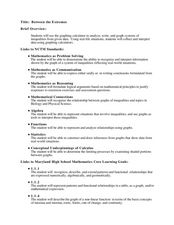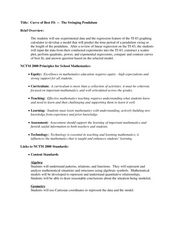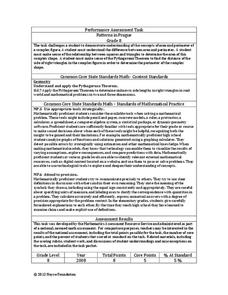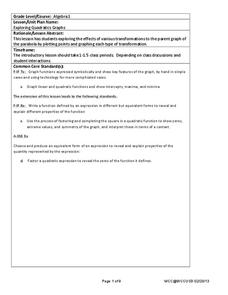Curated OER
Interesting Integers and Exciting Equations
An 80-page resource provides four lessons and all associated worksheets to teach middle schoolers about expressions and equations. The lessons are hands-on, using games, "integer chips," a balance and cubes, and cut and paste activities....
Virginia Department of Education
Inductive and Deductive Reasoning
Introduce pupils to the two types of reasoning, inductive and deductive. Classmates work in pairs or small groups to learn the difference between the two and apply these reasonings to develop valid conclusions.
Curated OER
Combining Like Terms and Solving
For this combining like terms and solving worksheet, students combine terms in simple algebraic equations and solve for the unknown. When needed, kids may observe step-by-step instructions to solve given equations. There are 20...
Curated OER
Exponents of Variables Worksheet
On this algebra worksheet, students complete 20 computation problems involving multiplying exponents by exponents. Answers can be checked by selecting the link at the end of the page.
Curated OER
Finding a GCF of Two Terms
For this Algebra worksheet, students find the Greatest Common Factor of two terms involving constants and variables with exponents. Students may self correct their answers by selecting the link at the end of the worksheet.
Curated OER
Factoring a GCF From an Expression
In this Algebra worksheet, students find the Greatest Common Factor of two or three terms and divide it out. They rewrite the expression using parenthesis. Students may self check their answers by selecting the link at the end of the...
Curated OER
Factoring a Trinomial
In this algebra learning exercise, students factor twenty trinomials into the appropriate binomial pair. Students may self-correct their work by selecting the link at the bottom of the page.
Curated OER
Guess the Age
Students rewrite word problems using symbols. In this algebra lesson, students rewrite equations graphically, algebraically and verbally. They relate the concepts to the real world.
Curated OER
Don't Let Parabolas Throw You
Students identify relation, function, patterns and range. For this algebra lesson, students factor and graph quadratic equations. They use transformation to move the parabola around and make predictions.
Curated OER
Between The Extremes
Students analyze graphs for specific properties. In this algebra lesson, students solve equations and graph using the TI calculator. They find the different changes that occur in each graph,including maximum and minimum.
Curated OER
Slippery Slope
Students define patterns, relation and function. In this algebra lesson, students find the slope of a line and write equations of line. They model the slope using real life scenarios.
Curated OER
How Do They Relate? Linear Relationship
Pupils collect information and use a line to represent it. In this algebra lesson, students investigate real world data to see if it makes a line. They graph the line comparing the relationship of the x axis with that of the y...
Curated OER
Leap Into Exponential Functions
Studens identify the properties of exponents. In this algebra lesson plan, students grapha nd solve equaitons of exponential functions. They add, subtract, multiply and divide using exponents.
Curated OER
Leap Into Exponential Functions
Students use properties of exponents to solve equations. In this algebra lesson, students add, subtract, multiply and divide exponential functions. They graph and differentiate between exponential growth and decay.
Curated OER
The Swinging Pendulum
Students observe a pendulum and graph their observation. In this algebra lesson, students use the TI calcualtor to graph the motion the pendulum makes. They analyze the graph and make predictions.
Curated OER
In Debt or Not In Debt
Students investigate the use of credit cards. In this algebra instructional activity, students differentiate the interest rate of credit cards and how to stay debt free. They identify pros and cons of credit cards.
Curated OER
Drag and Drop
In this inequalities instructional activity, students match definitions with their symbols or names. Each of the seven terms has a number which is dragged to the definition. When all seven terms have been matched, the computer scores,...
Curated OER
Linear Inequalities
Ninth graders explore solving linear inequalities. They discuss vocabulary words and symbols associated with linear inequalities. After a demonstration by the teacher, 9th graders solve and graph inequalities. Students complete a...
Curated OER
An Introduction to Public Key Cryptography
Students secure information online using cryptography. In this algebra lesson, students use RSA technology to encrypt information on the internet. They use modular reduction of natural numbers to understand prime number theory.
Noyce Foundation
Parallelogram
Parallelograms are pairs of triangles all the way around. Pupils measure to determine the area and perimeter of a parallelogram. They then find the area of the tirangles formed by drawing a diagonal of the parallelogram and compare their...
Noyce Foundation
Sewing
Sew up your unit on operations with decimals using this assessment task. Young mathematicians use given rules to determine the amount of fabric they need to sew a pair of pants. They must also fill in a partially complete bill for...
Inside Mathematics
Patterns in Prague
Designers in Prague are not diagonally challenged. The mini-assessment provides a complex pattern made from blocks. Individuals use the pattern to find the area and perimeter of the design. To find the perimeter, they use the Pythagorean...
West Contra Costa Unified School District
Exploring Quadratics and Graphs
Young mathematicians first graph a series of quadratic equations, and then investigate how various parts of the equation change the graph of the function in a predictable way.
West Contra Costa Unified School District
Solving Systems of Inequalities
Don't throw away those transparency sheets just yet! Young scholars first review inequalities on a number line, then learn about graphing inequalities in the coordinate plane. Finally, they use overhead transparencies to create systems...























